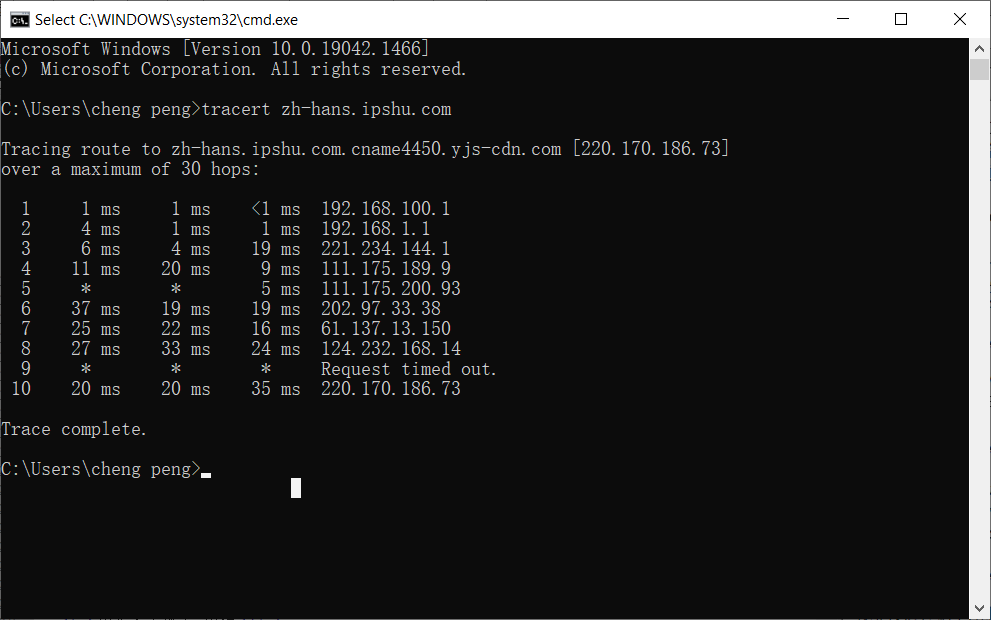Trace Route: 47.150.92.131
Trace Route from Server (172.16.5.201) to IP 47.150.92.131. Traceroute is a computer network diagnostic tool for displaying the route (path) and measuring transit delays of packets across an Internet Protocol (IP) network.
📱 Input
Loading...
What is traceroute?
Tracingroute is a commonly used network diagnostic command for computers. In Linux system, you can use traceroute; and in Windows, you can use tracert. With this command, we can track the packets from the host and obtain the statistics on the network latency of these packets, which is an estimate of how far the communication ended.
What does traceroute/tracert do?
The communication between two hosts often needs to go through many intermediate nodes. By using the traceroute/tracert command, you can track and locate the list of all routers that pass between the source host and the target host. After trying different hops, you can finally determine that the network problem is occurring on the gateway or the host.
What is the difference between traceroute/tracert and ping?
Both ping and traceroute/tracert are common commands for troubleshooting network problems, and you can use either one. But there are subtle differences. Ping is mainly used to test the reachability of network devices. Whereas traceroute is used to "trace" the route a packet goes through when it reaches its destination.
How to use the traceroute/tracert command?
- Press Windows key + R to open the Run window.
- Type cmd and click OK to open a Command Prompt.
- Enter tracert, a space, then the IP address or hostname, and finally press Enter.
What is the meaning of the information output when performing the traceroute/tracert command?
Let's take zh-hans.ipshu.com as an example to trace router on a windows system, you can get the following information.
Row:
The first row: describes the purpose of the command, and lists the target host/IP address (220.170.186.73), and the maximum hops the trace will traverse (30).
Subsequent rows: display the information of 10 hops (each hop corresponds to a router), which is the path from the start point to the destination. This trace went through these routes: Gateway address of LAN Wuhan Telecom, Hubei Province, China Zhuzhou Telecom, Hunan Province, China
The last row: shows the destination of the traceroute. It is the CDN node of Baidu Cloud Acceleration in Zhuzhou, Hunan Province, China.
Column:
The first column: the sequence number indicates the hop order of the path.
The 2~4 columns: round-trip time. It refers to the time it takes for a packet to reach the hop and then return to the sender. It is measured in milliseconds. An * indicates that the packet did not return within the expected time.
The last column: IP addresses. They are the Internet Protocol (IP) address of the host to which the router or domain name is bound.

Wikipedia : Traceroute(en)
In computing, traceroute and tracert are computer network diagnostic commands for displaying possible routes (paths) and measuring transit delays of packets across an Internet Protocol (IP) network. The history of the route is recorded as the round-trip times of the packets received from each successive host (remote node) in the route (path); the sum of the mean times in each hop is a measure of the total time spent to establish the connection. Traceroute proceeds unless all (usually three) sent packets are lost more than twice; then the connection is lost and the route cannot be evaluated. Ping, on the other hand, only computes the final round-trip times from the destination point.
For Internet Protocol Version 6 (IPv6) the tool sometimes has the name traceroute6 and tracert6.
Implementations
The command traceroute is available on many modern operating systems. On Unix-like systems such as FreeBSD, macOS, and Linux it is available as a command line tool. Traceroute is also graphically accessible in macOS within the
🌐: تتبع المسار, Traceroute, Traceroute, Traceroute, Traceroute, تریس روت, Traceroute, Traceroute, Traceroute, Traceroute, Traceroute, Traceroute, Traceroute, Traceroute, Traceroute, Traceroute, Traceroute, Traceroute, Traceroute, Traceroute, Traceroute, Traceroute, Traceroute, Traceroute,
 IP
IP

